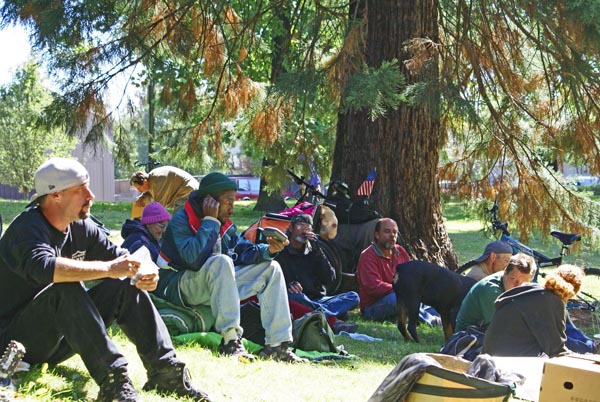
HARD FACTS ON HOMELESSNESS
A study done by the National Law Center on Homelessness and Poverty states that approximately 3.5 million people in America, 1.35 million of them children, are likely to experience homelessness in a given year. (1)
Approximately 40% of homeless men are veterans, although veterans comprise only 34% of the general adult male population. The National Coalition for Homeless Veterans estimates that on any given night, 200,000 veterans are homeless. (2)
Approximately 3,500 people are homeless in Lane County, Oregon.For the millions of homeless, quality of life takes on a far more fundamental quality—day-to-day survival. Quality is about finding a place to sleep each night out of the cold, snow or rain. It is about eating one’s next meal. It is about living one’s life in a surreal “reality” where one’s name, identity and life story do not matter. It is about reducing life’s quality to nearly animal levels, running in packs with other homeless persons as the group endures the daily ritual of seeking shelter, food and warmer clothing… in order to survive. It is about being blamed for one’s very homelessness (labeled as the “unworthy” poor), despite the fact that so much of this insidious condition is, in fact, caused (and perpetuated) by a tangled and messy multitude of underlying factors. It is about being voiceless in changing the conditions which could contribute to solutions—viewed as without dignity, ideas, or deeper felt human/spiritual needs. (3)
National Law Center
On Homelessness and Poverty
Myths and Facts about Homelessness
It is a tragic aspect of our culture that homeless people, in addition to suffering from the hardship of their condition, are subjected to alienation and discrimination by mainstream society. It is even more tragic that alienation and discrimination often spring from incorrect myths and stereotypes which surround homelessness. The following examines some of the myths and the realities about homelessness.
Arrest Records of Homeless People
Myth: Homeless people commit more violent crimes than housed people.
Fact: Homeless people actually commit less violent crimes than housed people.
The Magnet Theory
Myth: Setting up services for homeless people will cause homeless people from all around to migrate to a city.
Fact: Studies have shown that homeless people do not migrate for services. To the extent they do move to new areas, it is because they are searching for work, have family in the area, or other reasons not related to services.
A recent study found that 75% of homeless people are still living in the city in which they became homeless.
The Chronic Theory
Myth: Homeless people are a fixed population who are usually homeless for long periods of time.
Fact: The homeless population is quite diverse in terms of their length of homelessness
and the number of times they cycle in and out of homelessness.
Homeless Population Demographics
Myth: Homeless people are mostly single men.
Fact: Families constitute a large and growing percentage of the homeless population.
Employment
Myth: Homeless people don't work and get most of their money from public assistance programs.
Fact: Homeless people do work, and a relatively small percentage of them receive government assistance.
A study done in Chicago found that 39% of homeless people interviewed had worked for some time during the previous month.
Substance Abuse and Mental Illness
Myth: All homeless people are mentally ill or substance abusers.
Fact: Around a quarter of homeless people are mentally ill, and about 40% are alcohol or substance abusers, with around 15% suffering both disabilities. (4)Why Are People Homeless?
POVERTY
Homelessness and poverty are inextricably linked. Poor people are frequently unable to pay for housing, food, childcare, health care, and education.Eroding Work Opportunities, Decline in Public Assistance
HOUSING
A lack of affordable housing and the limited scale of housing assistance programs have contributed to the current housing crisis and to homelessness.Lack of Affordable Health Care: For families and individuals struggling to pay the rent, a serious illness or disability can start a downward spiral into homelessness, beginning with a lost job, depletion of savings to pay for care, and eventual eviction.
Domestic Violence: Battered women who live in poverty are often forced to choose between abusive relationships and homelessness.
Mental Illness:
Addiction Disorders: While rates of alcohol and drug abuse are disproportionately high among the homeless population, the increase in homelessness over the past two decades cannot be explained
by addiction alone.
CONCLUSION
Homelessness results from a complex set of circumstances that require people to choose between food, shelter, and other basic needs. (5)
FREE PEOPLE is committed to serving our local homeless population. Regardless of what brought these folks to this place in life, we are here to share hope for life recovery; physical, emotional and spiritual.
FOOTNOTES:
(1) National Coalition for the Homeless(2) National Coalition for Homeless Veterans
(3) Evangelicals for Social Action
© 2008 Free People, Inc.
